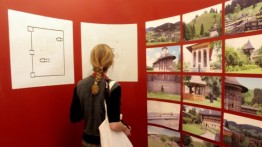Annual Menschel Fellowship Showcases Cross-Disciplinary Thinking
POSTED ON: February 1, 2013
This week the work of the Benjamin J. Menschel Fellows, eight students who focused on a yearlong project either collaboratively or individually, went on public display on the 6th and 7th floors of the Foundation Building. The works will be on view until February 9. The Menschel fellowship enables Cooper students from all three schools to pursue a long-term project of creative inquiry that often involves travel. This year's five projects take the viewer far and wide from the Deep South to the Aleutian Islands in the Bering Sea to the valleys of Romanian Moldavia. Often built on work that started in the classroom, each project exemplifies the cross-disciplinary, unconventional thinking characteristic of Cooper Union students.
Ariel Jackson, a senior from the School of Art, used her fellowship to travel home to Louisiana to interview extended family members about perceptions of black identity. There she researched family archives and talked to extended family about their own self-understanding of Creole identity. Her presentation in this year’s exhibition collects photo documents from some of those archives and presents three video interviews with family members that orbit around the questions of race, American identity, and history. "The Menschel [fellowship] deals with the long-term," she says, "you are given more time to explore a subject and allow yourself to be exposed to new possibilities.”
![Photograph from David Varon and Zulaikah Ayub's project "Contested [+] Territory"](/sites/default/files/uploads/assets/site/images/COLD-BAYsm.jpg)
Alexandra Alexa and Ben Johnson, two architecture students, journeyed to the Carpathian Mountains in Romania for their fellowship project. There, the duo researched small Orthodox Christian chapels dating back to the 14th and 15th centuries. Inside the chapels original frescoes depict biblical scenes in sequence for the visual pleasure and edification of what was a largely illiterate congregation. Reproductions of the frescos adorn the outside of the installation where visitors can freely admire them. This contrasts with the experience of entering the narrow installation that "scripts" your movements, echoing the linearity of the frescos.
Other projects include Joe Riley and Audrey Synder of the School of Art traveling forgotten railroad tracks of Northern California in search of history of "tramp printing". The two exhibit the modified bicycle they constructed to traverse the tracks themselves. Zulaikha Ayub and David Varon of the School of Architecture examined the postcolonial legacies of the Aleutian Islands through landscape photography and an interview with a native scholar of the region. Priscilla Aleman of the School of Art created sculptures exploring the physical spaces between two bodies interacting.
“The fellowship is often used as a stepping stone to graduate and post-graduate projects,” Sohnya Sayres, a Professor of the Faculty of Humanities and Social Sciences and Director of the fellowship, says. Indeed, a number of Menschel fellowship recipients continue their work on more ambitious projects. Julien Caubel is one. A 2011 mechanical engineering graduate of the Albert Nerken School of Engineering, he traveled to Ghana in 2011 on a Menschel Fellowship to work on a project about developing sustainable power for rural African communities utilizing bio-waste and recycled material. After graduating he revised his project slightly, and continued on as a Fulbright Fellow.






